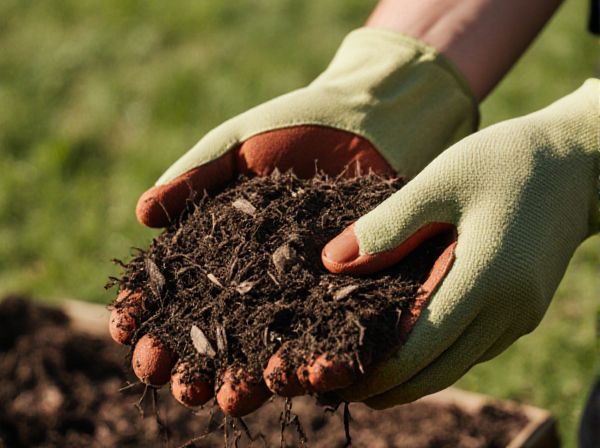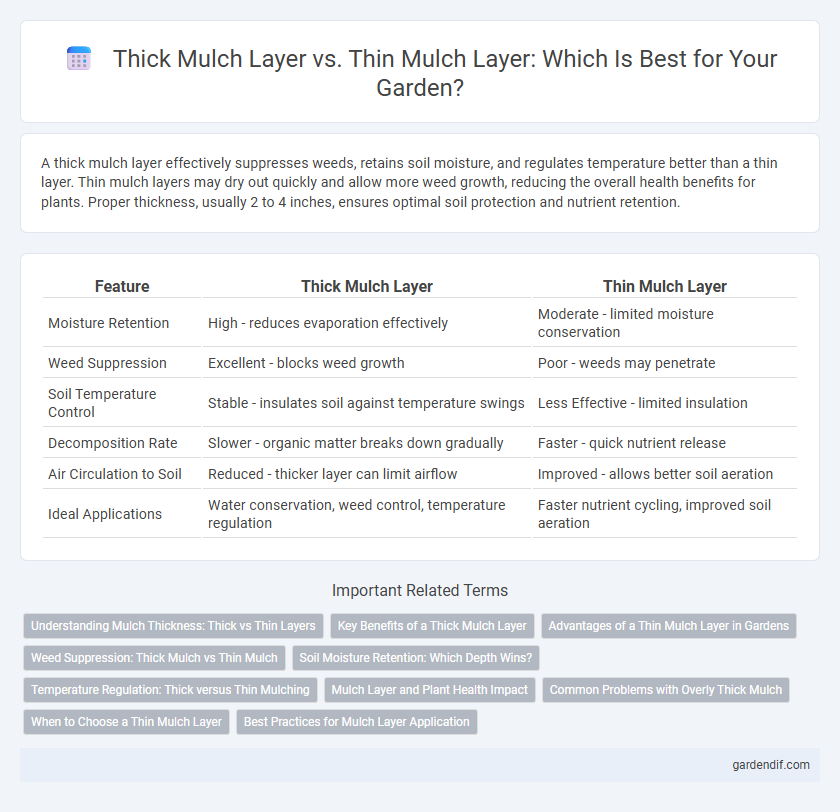
Thick mulch layer vs Thin mulch layer Illustration
A thick mulch layer effectively suppresses weeds, retains soil moisture, and regulates temperature better than a thin layer. Thin mulch layers may dry out quickly and allow more weed growth, reducing the overall health benefits for plants. Proper thickness, usually 2 to 4 inches, ensures optimal soil protection and nutrient retention.
Table of Comparison
| Feature | Thick Mulch Layer | Thin Mulch Layer |
|---|---|---|
| Moisture Retention | High - reduces evaporation effectively | Moderate - limited moisture conservation |
| Weed Suppression | Excellent - blocks weed growth | Poor - weeds may penetrate |
| Soil Temperature Control | Stable - insulates soil against temperature swings | Less Effective - limited insulation |
| Decomposition Rate | Slower - organic matter breaks down gradually | Faster - quick nutrient release |
| Air Circulation to Soil | Reduced - thicker layer can limit airflow | Improved - allows better soil aeration |
| Ideal Applications | Water conservation, weed control, temperature regulation | Faster nutrient cycling, improved soil aeration |
Understanding Mulch Thickness: Thick vs Thin Layers
Thick mulch layers, typically 3 to 4 inches deep, conserve soil moisture more effectively, suppress weeds better, and regulate soil temperature, promoting healthier plant growth. Thin mulch layers under 1 inch provide limited benefits, often allowing weeds to penetrate and soil to dry out faster. Proper mulch thickness balances water retention and aeration, optimizing garden health and enhancing soil microbial activity.
Key Benefits of a Thick Mulch Layer
A thick mulch layer, typically 3 to 4 inches deep, offers superior moisture retention by reducing evaporation and stabilizing soil temperature, which promotes healthier root development. This dense coverage effectively suppresses weed growth, minimizing competition for nutrients and reducing the need for chemical herbicides. Moreover, a thick mulch layer enhances soil structure by gradually decomposing and adding organic matter, improving aeration and nutrient availability for plants.
Advantages of a Thin Mulch Layer in Gardens
A thin mulch layer in gardens provides better soil aeration and allows water to penetrate more efficiently, preventing root rot and promoting healthy plant growth. It reduces the risk of fungal diseases and pests by minimizing excess moisture retention compared to thick mulch layers. Thin mulch also conserves resources by requiring less material while still effectively suppressing weeds and maintaining soil temperature.
Weed Suppression: Thick Mulch vs Thin Mulch
A thick mulch layer, typically 3 to 4 inches deep, significantly improves weed suppression by blocking sunlight and preventing weed seed germination more effectively than a thin mulch layer of 1 to 2 inches. Thin mulch layers allow more light penetration, enabling weed seeds to sprout and compete with plants for nutrients and moisture. Consistently maintaining a thick mulch layer reduces the need for chemical herbicides and labor-intensive weeding, promoting healthier plant growth and soil conditions.
Soil Moisture Retention: Which Depth Wins?
A thick mulch layer, typically 3 to 4 inches, significantly enhances soil moisture retention by reducing evaporation and maintaining consistent moisture levels. In contrast, a thin mulch layer under 1 inch provides minimal coverage, leading to faster moisture loss and less effective temperature regulation. Research shows that thicker mulch layers support healthier plant growth by improving hydration and fostering beneficial microbial activity in the soil.
Temperature Regulation: Thick versus Thin Mulching
A thick mulch layer provides superior temperature regulation by insulating soil against extreme heat and cold, maintaining a more stable root environment. Thin mulch layers offer limited protection, allowing greater temperature fluctuations that can stress plants and reduce growth efficiency. Optimal mulch thickness typically ranges from 2 to 4 inches to balance moisture retention and thermal insulation for healthy plant development.
Mulch Layer and Plant Health Impact
A thick mulch layer, typically 3 to 4 inches, effectively suppresses weeds, retains soil moisture, and moderates soil temperature, promoting robust root growth and overall plant health. In contrast, a thin mulch layer often fails to conserve moisture and control weeds adequately, leading to increased plant stress and vulnerability to pests and diseases. Proper mulch depth ensures optimal soil microclimate, enhances nutrient availability, and supports beneficial microbial activity essential for healthy plant development.
Common Problems with Overly Thick Mulch
An overly thick mulch layer, typically exceeding 4 inches, can suffocate plant roots by restricting air and water penetration, leading to root rot and poor plant health. Excessive mulch creates a habitat for pests like rodents and fungi, increasing the risk of infestations and diseases. Proper mulch depth, usually 2 to 3 inches, balances moisture retention and soil aeration, preventing these common issues.
When to Choose a Thin Mulch Layer
Choose a thin mulch layer when dealing with young seedlings or newly planted beds to prevent moisture retention issues and allow adequate oxygen flow to roots. Thin mulch, typically 1 to 2 inches thick, helps regulate soil temperature without suffocating plant growth or encouraging fungal diseases. It is ideal for faster soil warming in early spring and regions with high rainfall where excessive moisture retention could harm plants.
Best Practices for Mulch Layer Application
A thick mulch layer, typically 3 to 4 inches, conserves soil moisture effectively and suppresses weed growth, promoting healthier plants. Thin mulch layers, less than 2 inches, may dry quickly and allow weeds to penetrate, reducing mulch efficiency. Best practices recommend evenly applying a thick mulch layer while avoiding piling mulch against plant stems to prevent rot and pest issues.
Thick mulch layer vs Thin mulch layer Infographic

 gardendif.com
gardendif.com